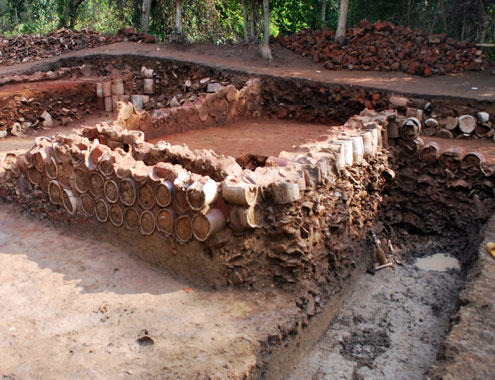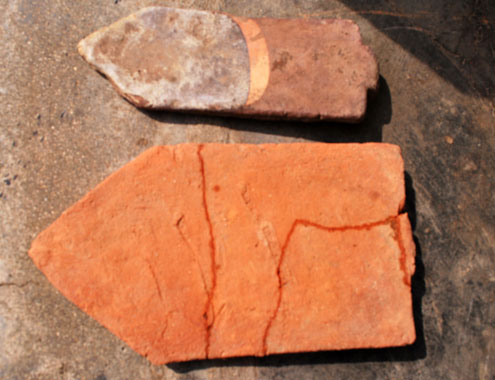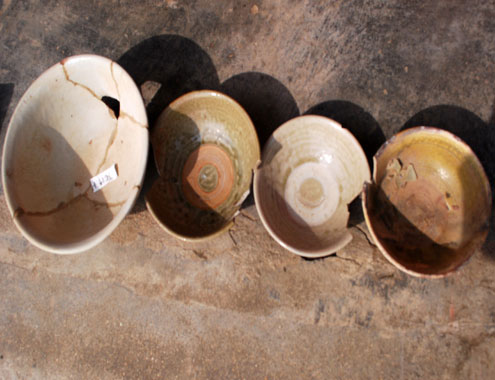Discovered the remains of four 800-year-old ceramic kilns
After nearly a month of excavation of Truong Cuu mound (An Nhon town), Binh Dinh Museum discovered traces of at least 4 800-year-old ceramic kilns in Champa culture.
On January 22, Dr. Dinh Ba Hoa - Director of Binh Dinh Museum - said that through excavation, this unit and experts from the Vietnam Academy of Social Sciences discovered in Truong Cuu that there was little evidence. most 4 ceramic kilns dating back to the 13th century (equivalent to about 800 years) were built on each other.

Traces of four 800-year-old pottery kilns discovered in Truong Cuu mound.(Photo: Dinh Ba Hoa)
At this mound, archaeologists also found many bowls, plates, jars, pots . Pottery is mainly monochrome, celadon celadon. Architectural objects in the kiln are quite diverse, including large size hook tiles, glazed tiles. Prominently, there are two pieces of terracotta tiles shaped like a one-inch-wide and 30cm-wide curving shape, very rare, decorative materials used to attach to imperial palaces, build Champa towers .

Large-sized hook tiles, a typical construction material of Champa culture found in Truong Cuu mound.(Photo: Dinh Ba Hoa)
Truong Cuu is the name of the mound located along the Con river bank, close to the eastern edge of Cha (one of the four ancient Champa citadel) in Nhon Loc commune, An Nhon town. This area also has many glazed and glazed pottery pieces along the Con river bank. The ceramic kiln here has a rectangular shape and is of the type of a furnace chamber.

Celadon celadon bowl is found in Truong Cuu relic.(Photo: Dinh Ba Hoa)
After many archaeological excavations, Binh Dinh Museum recorded about six ceramic production centers, of which An Nhon town has three Go Sanh kilns (Nhon Hoa commune) and Cay Me (Nhon My commune). ) and Truong Cuu (Nhon Loc commune).
"The discovery of a hundred-year-old ceramic kiln in Truong Cuu school this time adds evidence to confirm that Champa people have a very long tradition of traditional pottery, each had a close exchange with Vietnamese culture, and made certain contributions. world history of pottery production " , Mr. Hoa added.
- China unearthed dragon-shaped kilns over 1200 years
- Find the message behind the 3,000-year-old ceramic piece
- Discovered the 5,000-year-old homosexual remains
- Intact salvage of ceramic vessels dating back more than 2,000 years
- Discovered a 5,000-year-old brewery in northern China
- Discovered a 2700-year-old treasure at the holy site of Jerusalem
- Mexico unearthed the temple of wind gods under the supermarket nail
- Discovered the 7,000-year-old remains buried in strange posture
- Rediscover the 6,500-year-old remains
- Mexico studied 30 sets of ancient remains
- Discover 1,600-year-old glass furnace in Israel
- Discovered the 2,000-year-old remains of 'Sleeping Beauty in the Forest' in Ethiopia
 Discovered an ancient centipede fossil 99 million years old
Discovered an ancient centipede fossil 99 million years old Discovered bat-like dinosaurs in China
Discovered bat-like dinosaurs in China Discovered a 200-year-old bronze cannon of the coast
Discovered a 200-year-old bronze cannon of the coast Discover 305 million-year-old spider fossils
Discover 305 million-year-old spider fossils